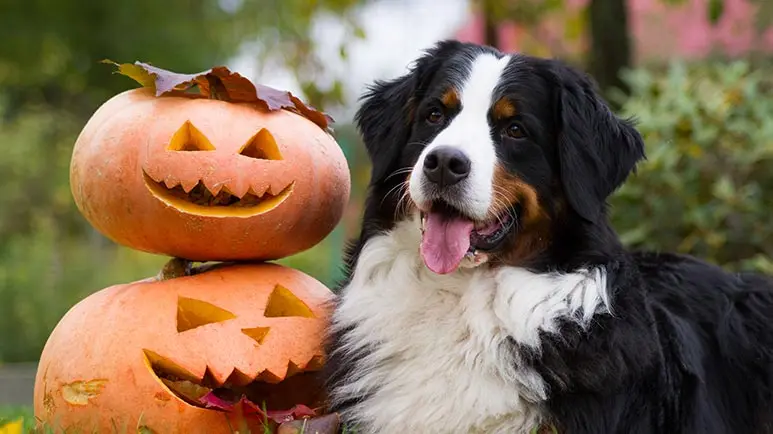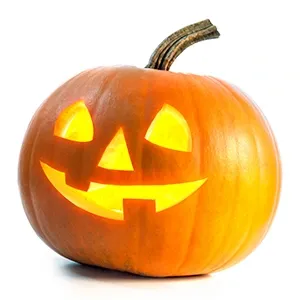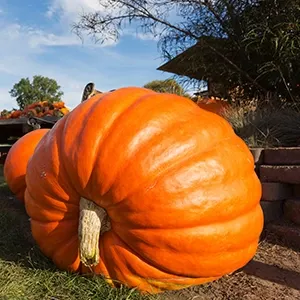Pumpkin: This Halloween Mainstay Can Be Good for Your Pet
If you've carved your jack-o'-lanterns for tonight's festivities, make sure to set aside the pumpkin seeds and the flesh. Try making these delicious pumpkin pet cookies — a great snack your pet will enjoy!

STORY AT-A-GLANCE
- Pumpkin may help regulate your pet's bowel movements and facilitate gastric emptying because it's a good fiber source
- Pumpkin contains numerous vitamins and other nutrients essential for your pet's health, including vitamin C, zeaxanthin, lutein and beta carotene
- Pumpkin pies and puddings are not recommended for pets as they contain high amounts of sugar and possibly other chemical additives
Join the Bark & Whiskers™ Family
Sign up today for our FREE newsletter, packed with expert advice and insider tips to keep your beloved pet in tip-top shape.
View our Privacy Policy and Terms of Service.
Editor's Note: This article is a reprint. It was originally published October 7, 2020.
Whenever Halloween comes around, the jack-o'-lanterns come out! Typically made from pumpkins, this spooky lawn décor has been a cultural mainstay for hundreds of years. But don't forget that it's still food! Pumpkin can be prepared in myriad ways, and you know what's better? This versatile gourd can be enjoyed by your pet, too.
Research suggests pumpkin is a good source of soluble fiber, which helps regulate bowel movements and gastric emptying.1 It also provides alkaloids, flavonoids and fatty acids.2 Read on to learn more about pumpkin and why it should be enjoyed by your family and pet throughout the year, not just on Halloween.
Pumpkin Has Powerful Bioactive Compounds
Pumpkin is highly regarded for its medicinal properties, which is thanks to the surplus of phytochemicals it contains, including alkaloids, flavonoids and fatty acids.3
In a 2020 study from CyTa - Journal of Food, researchers note that pumpkin is rich in bioactive compounds, like beta-carotene, zeaxanthin and lutein — three carotenoids that are well-known for their ability to help curb inflammation, oxidative damage and mitochondrial dysfunction.4,5
Beta-carotene, considered the most prominent member of all the carotenoids, is a strong antioxidant and precursor of vitamin A. In the Encyclopedia of Human Nutrition, beta-carotene is said to have protective properties against abnormal tissue growths, eye disorders and cardiovascular disease.6
Lutein and zeaxanthin are two carotenoid antioxidants that play crucial roles in eye health and disease prevention. In a 2016 study from the Annual Review of Nutrition, researchers discuss how lutein and zeaxanthin help curb inflammation by preventing the production of oxidation-induced cytokines and the expression of inflammation-related genes, which may help stop the development of chronic diseases related to inflammation.7
Pumpkin Fun Fact

You know it's Halloween when you see the jack-o'-lanterns out in the front yard. But where did this tradition come from? According to historians, it originated in Ireland based on the Stingy Jack myth. The Irish used turnips back in Ireland, but immigrants used pumpkins as they were abundant in America.8
Pumpkin Provides Pets with Fiber for Healthy Digestion
Pumpkin is a fiber-rich food that you can give to your pets as a healthy treat. While cats and dogs don't need fiber in their diet,9 fiber in pumpkin can assist your pet's digestive tract by helping stop the overgrowth of bad bacteria in their intestines.
It also reduces symptoms of diarrhea and constipation by regulating the speed of intestinal transit time — slowing it down during periods of diarrhea and speeding it up during constipation.10 A two-tablespoon serving of boiled pumpkin can give your pets about 0.34 grams of fiber.11
However, remember that while a small amount of fiber is very important, a diet loaded with fiber can be very detrimental as well. If your dog is experiencing digestive issues like constipation and loose stools, giving them about 1 teaspoon of pumpkin for every 10 pounds of body weight, mixed in with their food one to two times a day, is enough to help alleviate these problems.
Pumpkin Protects Your Pets from Oxidative Damage with Vitamin C
A 2-tablespoon serving of pumpkin provides 1.44 milligrams of vitamin C,12 which is essential for strengthening your pet's immune system to combat diseases. Vitamin C is also a well-known antioxidant and free radical scavenger, which may help protect your pets from inflammation and even cancer.13,14,15
Did You Know?

The world's heaviest pumpkin was harvested in Germany. It weighed a whopping 1,600 pounds, which is about the weight of a full-grown giraffe!16,17
Here's How You Can Give Pumpkin to Your Pets
While some sites may say that pumpkin is unsafe for pets due to the risk of overconsumption, note that misinformation about many healthy fruits, vegetables, nuts and seeds abounds on the internet. This is because websites have labeled all risks (such as the risk of overconsumption causing gastrointestinal issues, or choking on too large of pieces or pits) as "toxicities," which isn't true but has managed to confuse millions of pet lovers, nonetheless.
Pumpkin is a safe treat or food topper for pets; just make sure that treats like this only make up less than 10% of their daily caloric intake. Feed them 100% plain, pure pumpkin — not pumpkin pie filling. Products that boast pumpkin as their main ingredient, such as pumpkin pie mixes or pumpkin pudding, may contain high levels of sugar or additives that are not beneficial for pets.
If possible, opt for organic, "spray-free" pumpkin from local farmers. If fresh pumpkin is unavailable, though, you can opt for 100% pure, canned pumpkin from trustworthy organic brands.
According to the Environmental Working Group, winter squash (the gourd family that includes pumpkins) ranks 14th in their Shopper's Guide to Pesticides in Produce.18 This means there may be a fair amount of pesticide in the pumpkin you're buying.
Pumpkin Seeds Are Just as Nutritious as the Fruit
The oil in pumpkin seeds contains α-tocopherol, γ-tocopherol, α-tocotrienol and γ-tocotrienol.19,20 These bioactive compounds are so powerful that pumpkin extracts taken from different parts of the pumpkin plant have antidiabetic, antibacterial, antioxidant and anticancer properties.21
You can also add a sprinkle of unsalted pumpkin seeds as "toppers" to your pet's meals. Pumpkin seeds not only add crunchiness to their food, but are also loaded with amino acids, phytosterols, phenolic compounds and cucurbitacins. These bioactive compounds have made pumpkin seeds a promising medicinal ingredient, thanks to their anthelmintic, antidiabetic, antidepressant and cytoprotective properties.22
Aside from these, cucurbitacins may help curb microbiological and parasitic infections in animals. In a 2020 study published in the International Journal of Molecular Sciences, researchers note the antiparasitic abilities of pumpkin seeds, thanks to cucurbitine, cucurbitacin B and cucurmosin.23,24
However, do not rely on pumpkin seeds alone to help remove parasites from your pet's digestive tract. If you suspect that they're suffering from parasitic infections, seek the advice of an integrative veterinarian immediately.
Top Producers of Pumpkins

Pumpkins are so hardy that they're able to grow in any continent in the world, except Antarctica. However, there's only one place that proudly calls itself the "Pumpkin Capital of the World": Morton, Illinois. About 95% of all pumpkins cultivated in the U.S. are grown in Illinois, with 80% of canned pumpkin coming from Morton alone.25
Check Out My Pumpkin Almond Cookies Recipe
Here's a great example of how to transform pumpkin into a healthy pet treat. For this recipe, you can use canned, 100% pure, organic steamed pumpkin or fresh pumpkin, whichever you have on hand:
Pumpkin Almond Cookies for Pets
Ingredients:
- 1/4 cup coconut flour
- 1 pastured egg
- 1/2 cup pumpkin
- 1 tablespoon almond butter
- 2 tablespoons coconut oil
- A dash of cinnamon, ginger or clove (optional)
Procedure:
- Add all the ingredients to a bowl and mix well.
- Place the cookies on a greased cookie sheet and bake at 325 degrees Fahrenheit for 30 minutes.
- Let the cookies cool before serving to your pets.
Sustainability of the Pumpkin Industry
The U.S. pumpkin industry is thriving and a big business. In 2022, it's estimated that $800 million worth of pumpkins were used for Halloween alone,26 which may have drastic effects on the environment. According to a report from FoodPrint, pumpkin cultivation can be a chemically intensive process. Many farmers use synthetic fertilizers as well as pesticides or fungicides to increase harvest.27
Fortunately, more farmers are beginning to use regenerative techniques to help minimize environmental damage. If possible, look for sustainable sources of pumpkin so you can contribute to this noble cause.28
There's also the issue of waste. About a billion pounds of pumpkins will eventually be sent to landfill sites, which may produce methane once broken down. To minimize your waste, use as much of the pumpkin as possible in your meals. You can compost the shells in a community garden once you're done.29
Sources and References
- 1 Food and Agriculture Organization of the United Nations, Physiological Effects of Dietary Fibre
- 2,3 Nutr Res Rev 2010 Dec 23(2):184-90
- 4 Antioxidants (Basel) 2020 Oct 26;9(11):1046
- 5 CyTa Journal of Food, 2020
- 6 Encyclopedia of Human Nutrition, 2013
- 7 Annu Rev Nutr. 2016 Jul 17; 36: 571–602
- 8 History, October 25, 2019
- 9 Cummings Veterinary Center at Tufts University Sept 1, 2017
- 10 American Kennel Club, March 14, 2024
- 11,12 USDA, Pumpkin, cooked, boiled, drained, without salt
- 13 Nutrients. 2017 Nov; 9(11): 1211 (Under Abstract)
- 14 Drug Des Devel Ther. 2015; 9: 3405–3412 (Under Conclusion)
- 15 Front Pharmacol. 2020; 11: 211 (Under Abstract)
- 16 Animal Corner, Giraffe
- 17 CNN, October 5, 2020
- 18 EWG, Shopper’s Guide to Pesticides in Produce 2023
- 19 EatingWell, August 12, 2021
- 20 Cold Pressed Oils, 2020
- 21 Nuts and Seeds in Health and Disease Prevention, 2020
- 22 Scientific African Volume 10, November 2020, e00575, Abstract
- 23 Scientific African, Volume 10, November 2020, e00575
- 24 International Journal of Molecular Sciences, 2016
- 25 Good Housekeeping, August 7, 2021
- 26,28,29 LinkedIn, October 13, 2022
- 27 FoodPrint, “Pumpkins”
Unlock Pro Tips for Pet Wellness
Get exclusive access to expert insights and holistic health tips for your furry friend – all for FREE because your pet’s well-being is our top priority.
View our Privacy Policy and Terms of Service.











